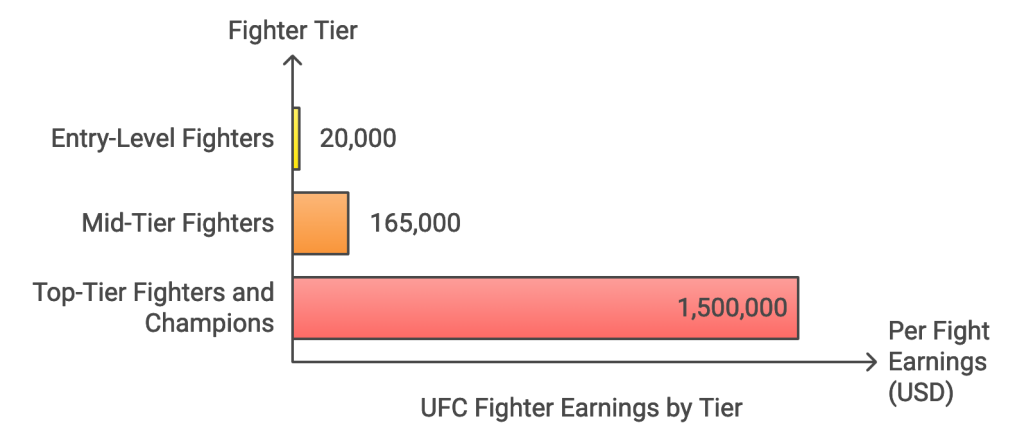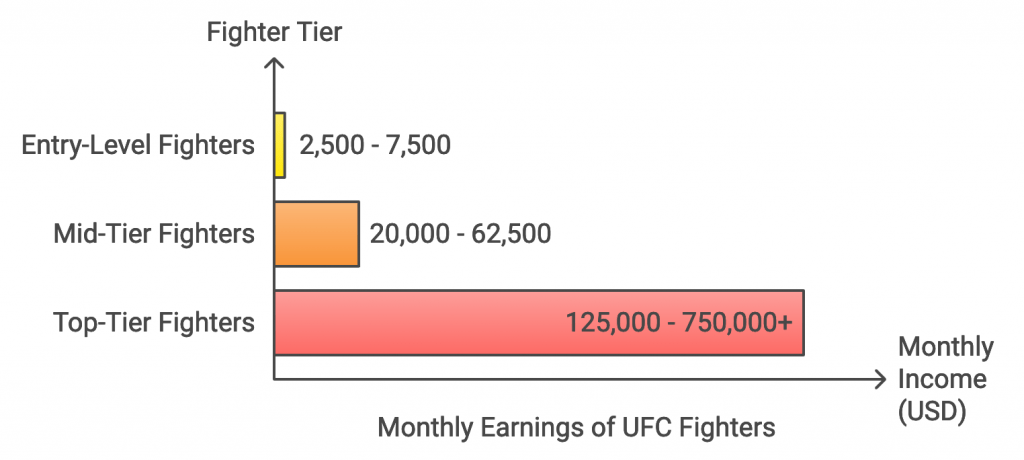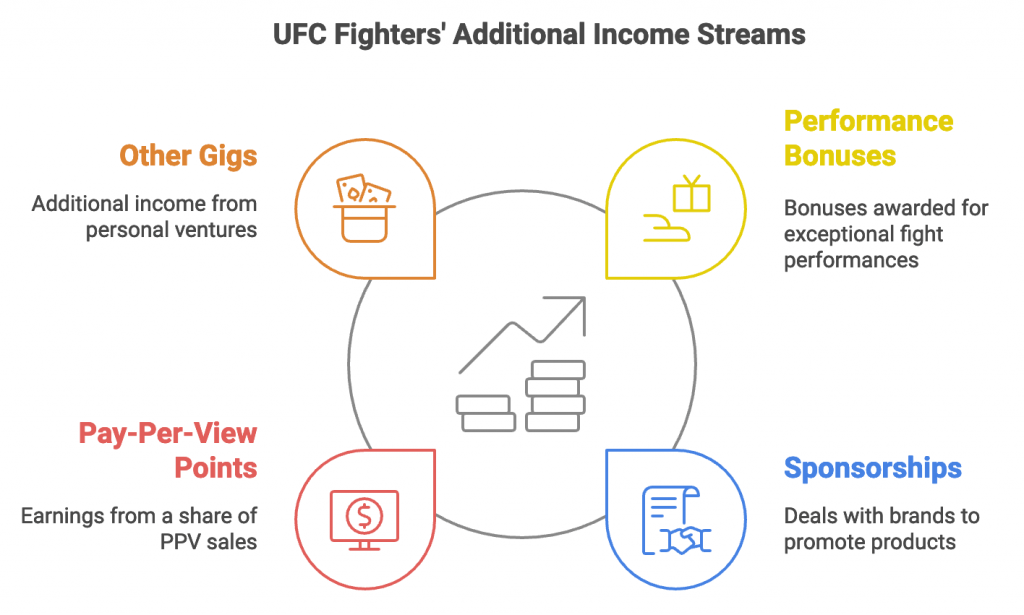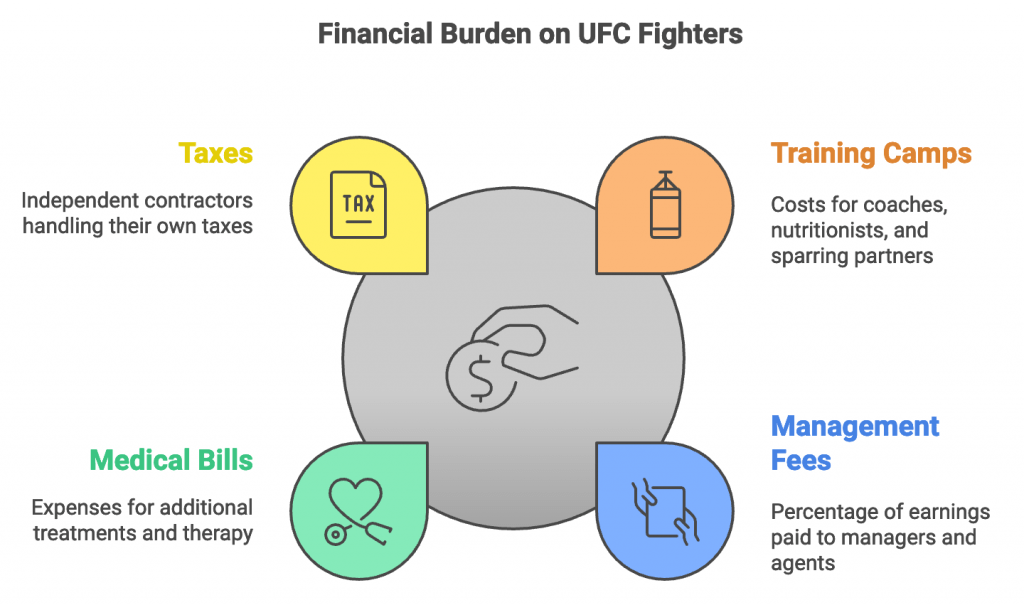Average UFC Fighter Salary: How Much Do Fighters Earn Per Fight and Per Month
Dreaming of stepping into the UFC Octagon? Whether you’re thinking of a career in the UFC or just curious about what fighters make, knowing how pay works in the UFC can be pretty eye-opening. Let’s uncover what these athletes take home per fight, per month, and how some fighters make the big bucks while others hustle to get by. From fight purses to performance bonuses and side gigs, here’s everything you need to know about UFC fighter pay.
Per Fight Earnings
Just like in any field, UFC fighter pay varies a lot. It depends on experience, fan popularity, and overall performance. Here’s a look at what fighters earn in each pay tier.
Entry-Level Fighters
Per Fight Earnings: $10,000- $30,000
When new to the UFC, fighters start at the bottom of the pay scale. Most entry-level fighters make between $10,000 and $30,000 per fight, with a chance to double that if they win. This tier includes athletes who recently joined the UFC through Dana White’s Contender Series or those with limited fight experience.
Mid-Tier Fighters
Per Fight Earnings: $80,000 – $250,000
Once a fighter has a few wins or a growing fan base, their earnings can jump to the $80,000 – $250,000 range. These fighters often make the main card and are more established, meaning their paychecks reflect their experience. Throw in a win bonus, and they could pocket up to $500,000 for a great performance.
Top-Tier Fighters and Champions
Per Fight Earnings: $500,000 – $3,000,000+
Now, here’s where the numbers get big. Top fighters – especially those with titles or huge followings – can earn anywhere from $500,000 to $3 million per fight. And that’s just the base pay! With PPV (pay-per-view) points and endorsements, their earnings can skyrocket even higher.

Monthly Earnings
A UFC fighter’s monthly income really depends on how often they fight. Most fighters enter the Octagon twice or thrice a year, meaning their annual earnings vary considerably. Here’s how it breaks down monthly:
Entry-Level Fighters
Monthly Income: $2,500 – $7,500
If a fighter earns $10,000 – $30,000 per fight and competes thrice a year, their annual income ranges from $30,000 to $90,000. Dividing that by 12 months, they’re looking at an average monthly income of about $2,500 to $7,500.
Mid-Tier Fighters
Monthly Income: $20,000 – $62,500
Once a fighter has a few wins or a growing fan base, their earnings can jump to the $80,000 – $250,000 range. These fighters often make the main card and are more established, meaning their paychecks reflect their experience. Throw a win bonus, and they could pocket up to $500,000 for an excellent performance.
Top-Tier Fighters and Champions
Monthly Income: $125,000 – $750,000+
Top-tier fighters earning between $500,000 and $3 million per fight (with three fights per year) could see annual incomes from $1.5 million to $9 million. Divided monthly, that’s $125,000 to $750,000—without counting the bonuses, PPV points, and endorsements.

Extra Cash: Bonuses, Endorsements, and PPV Points
Aside from base pay, UFC fighters can rake in extra cash through performance bonuses, sponsorships, and other incentives. Here’s how fighters add to their bank accounts beyond their per-fight earnings:
Performance Bonuses
The UFC awards $50,000 bonuses for incredible performances, including:
- Fight of the Night. Given to both fighters in the most exciting fight on the card.
- Performance of the Night. For fighters who achieve a knockout, submission, or outstanding skill showcase.
These bonuses motivate fighters to put on a show and can be a game-changer for mid- and lower-tier fighters.
Sponsorships and Endorsements
Sponsorship deals can also significantly increase a fighter’s income, especially for well-known names. Currently, Venum is the official UFC outfitter, but fighters can still secure outside sponsorships that help boost earnings.
Pay-Per-View (PPV) Points
Big-name fighters and champions sometimes get a cut of PPV sales, which can massively increase their pay for top-rated fights. When a fighter gets a percentage of PPV sales, their earnings can easily jump by millions if it’s a blockbuster event.
Other Side Gigs
Some fighters earn extra cash through personal training, online coaching, or brand launches. Fighters like Dustin Poirier have used their fame to create charity foundations, sell merchandise, and engage with fans on social media, increasing their earnings and overall reach.

Hidden Costs of Being a UFC Fighter
While UFC fighter pay sounds impressive, the reality is fighters face a ton of expenses that can cut into their take-home pay:
- Training Camps: Quality training doesn’t come cheap. Fighters spend a lot on training camps, paying for coaches, nutritionists, and sparring partners for each fight.
- Management Fees: Fighters often pay their managers and agents a percentage (usually 10-20%) of their earnings, which can add up, especially for high-paid fighters.
- Medical Bills: Though the UFC covers some medical costs, additional treatments or physical therapy for injuries outside the Octagon can be pricey.
- Taxes: As independent contractors, fighters must handle their taxes, which can significantly reduce their earnings.

Final Thoughts
While top fighters can earn millions, it’s a different story for most of the roster. Entry-level fighters sometimes struggle to break even after expenses, and only a handful of stars get those seven-figure paydays. With a career in the UFC, every fight matters, and paychecks grow based on hard-earned wins, fan support, and staying relevant. The rewards can be huge for those who make it to the top, but for most fighters, it’s a grind that requires smart financial management and a genuine love for the sport.



